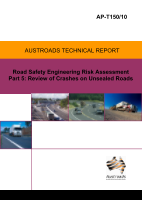Road Safety

Road Safety Engineering Risk Assessment Part 5: Review of Crashes on Unsealed Roads
- Publication no: AP-T150-10
- ISBN: 978-1-921709-05-0
- Published: 19 January 2010
- PDF (free) Download
A large proportion of the road network in Australia and New Zealand is unsealed (58% in Australia, 36% in New Zealand). It is important to understand what factors lead to the occurrence of crashes in this environment, and what measures may be undertaken to minimise them. This study involved a literature review and internet search, crash data analysis, workshop and site inspections of a number of unsealed road crash locations. The aim was to assess the incidence and severity of casualty crashes on unsealed rural roads, identify factors and likely causes, and assess potential countermeasures.
- 1. INTRODUCTION
- 1.1. Background
- 1.2. Objectives
- 1.3. Method
- 1.3.1. Task 1 – Literature Review
- 1.3.2. Task 2 – Data Analysis
- 1.3.3. Task 3 – Countermeasure Workshop
- 1.3.4. Task 4 – Site Inspections
- 1.4. Providing a Safe Road System
- 2. LITERATURE REVIEW
- 2.1. Extent of the Problem
- 2.1.1. Australia
- 2.1.2. New Zealand
- 2.1.3. Other Countries
- 2.2. Factors Contributing to Crashes on Unsealed Roads
- 2.3. Road Factors
- 2.3.1. Traffic Volume and Composition
- 2.3.2. Frequency and Nature of Intersections
- 2.3.3. Geometric Design Standards and Cross-section
- 2.3.4. Information Standards (Signing and Delineation)
- 2.3.5. Surface Condition
- 2.4. Human Factors
- 2.4.1. Speed, Drink Driving and Low Levels of Passenger Restraint Use
- 2.4.2. Fatigue
- 2.4.3. Driver Inexperience
- 2.5. Effectiveness of Remedial Treatments
- 2.6. Road Design, Construction and Maintenance
- 2.7. Education and Enforcement
- 2.8. Discussion
- 3. CRASH ANALYSIS
- 3.1. Crash Rates
- 3.2. Crash Data Analysis – Introduction
- 3.2.1. Limitations of the Crash Analysis
- 3.3. Crashes According to Severity
- 3.3.1. By Severity
- 3.3.2. By Year
- 3.3.3. By Time of Day
- 3.3.4. By Day of Week
- 3.3.5. By Vertical and Horizontal Alignment
- 3.3.6. By Light Conditions
- 3.3.7. By Weather Conditions
- 3.3.8. By Number of Vehicles
- 3.3.9. By Type of Vehicle
- 3.3.10. By Crash Type
- 3.3.11. By Intersection/Mid-block
- 3.3.12. By Traffic Control
- 3.3.13. By Controller Age and Sex
- 3.3.14. By Controller Licence Type
- 3.3.15. By BAC Result
- 3.3.16. By Restraint Use
- 3.3.17. By Object Hit
- 3.3.18. Crash Causation Factors
- 3.4. Discussion
- 4. WORKSHOP
- 4.1. Speed
- 4.2. Roadside Hazards
- 4.3. Maintenance
- 4.4. Traffic Mix
- 4.5. Fatigue/Drowsiness
- 4.6. Funding
- 4.7. Surface Conditions
- 4.8. Experience
- 4.9. Geometry
- 4.10. Data
- 4.11. Driver Type
- 4.12. Driver Behaviour
- 4.13. Alerting Emergency Services
- 4.14. Vehicles
- 4.15. Discussion
- 5. SITE INSPECTIONS
- 6. DISCUSSION AND SUMMARY
- 6.1. Prevalence
- 6.2. Contributory Factors
- 6.3. Countermeasures
- 6.4. Crash Reductions
- Road based hazards
- Driver contributions to crashes
- Road design, addressing hazards and maintenance
- Driver education, law enforcement and provision of facilities to assist drivers
- In-vehicle driver assistance technologies
- Safe system approach
- REFERENCES
- APPENDIX A AUSTROADS ROAD SAFETY ENGINEERING RISK ASSESSMENT PROJECT
- APPENDIX B ROAD LENGTH ACCORDING TO SURFACE TYPE
- APPENDIX C DATA ISSUES AND ASSUMPTIONS
- APPENDIX D ADDITIONAL CRASH CAUSATION FACTORS
Related publications
WEB-ZRT-24
Latest Road Safety News
